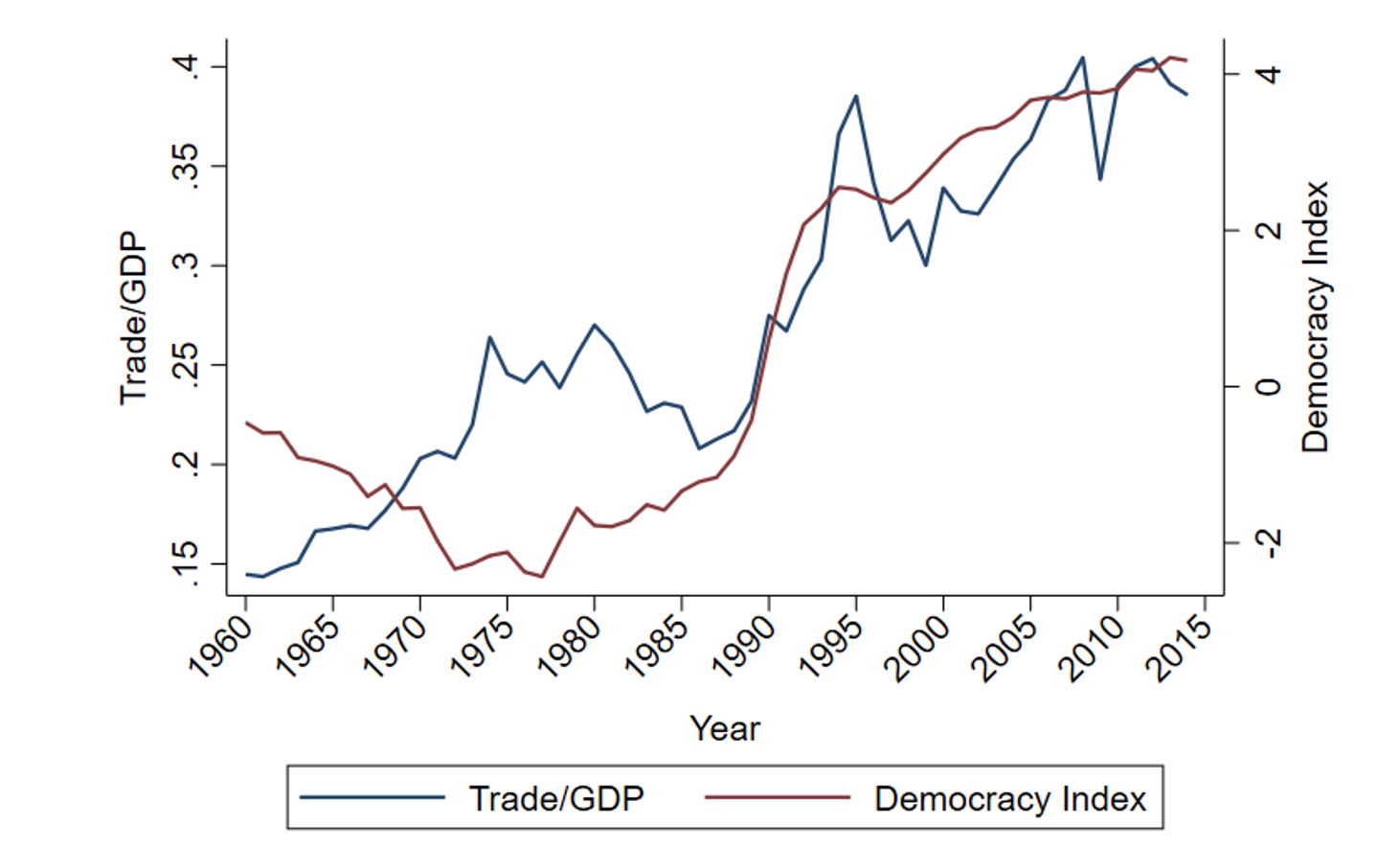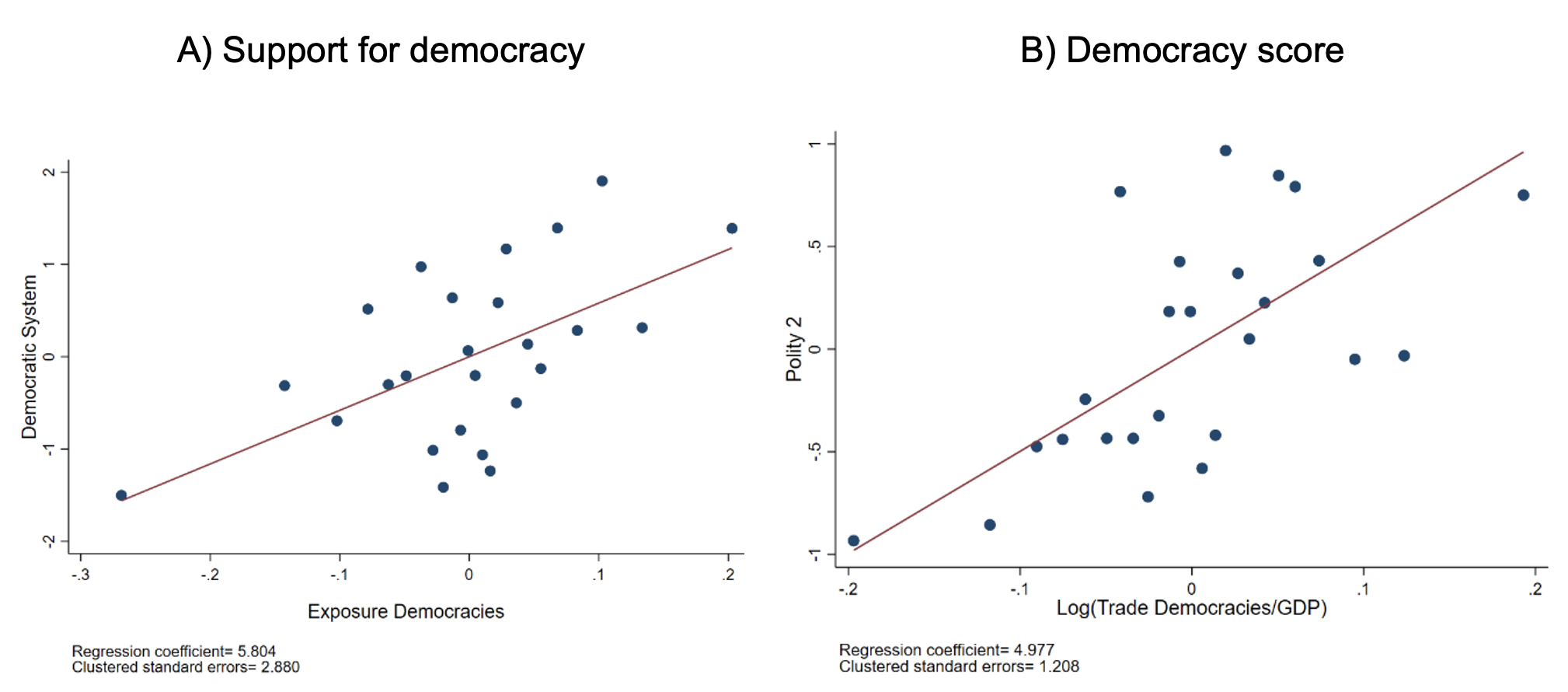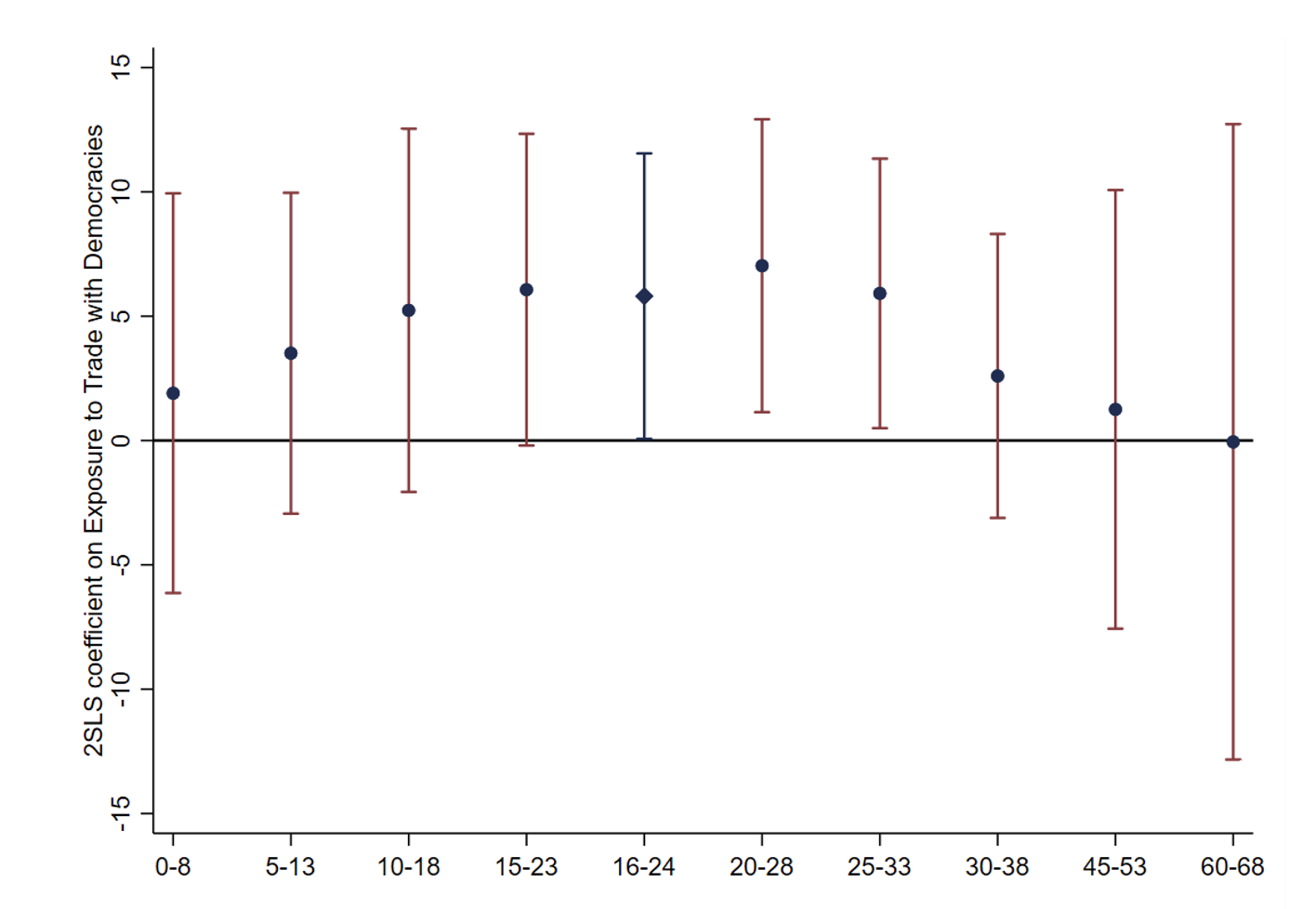Between 1960 and 2010, democracy and globalisation rose dramatically (see Figure 1). As a result, citizens of non-democratic countries might have been increasingly exposed to the institutions and the values of their more democratic partners. Does economic integration with democracies promote the transmission of democratic values and favour the consolidation of democracy across countries? Exposure to own democracy has been shown to improve both individuals’ attitudes towards democracy and the stability of countries’ institutions (Persson and Tabellini 2009, Acemoglu et al. 2021). Yet, less is known about the role that exposure to trade partners’ democracy can have on individuals’ support for democracy and on the quality of countries’ institutions.
Figure 1 Trends in economic integration and democracy
Source: Trade/GDP: average across countries in each year. Data from the IMF Direction of Trade Statistics and the Penn World Table, version 9.0. Democracy Index: average across countries in each year. Data from the Polity V project, Polity2 score.
In our recent paper (Tabellini and Magistretti 2023), we seek to fill this gap, studying the effects of economic integration with democracies on individuals’ attitudes and on countries’ institutions from 1960 to 2015. We begin by exploiting within-country, cross-cohort variation in individuals’ exposure to democracy of a country’s trade partners during their impressionable years (ages 16–24), a period in an individual’s life when political and economic preferences are particularly malleable to economic shocks (Giuliano and Spilimbergo 2022, 2023). We rely on data from the Integrated Value Surveys, which includes more than 220,000 respondents across 74 countries, to test whether individuals who grew up while their country was trading more with democratic partners are more supportive of democracy at the time of the survey. We compare individuals’ attitudes towards democracy between age cohorts that, during the impressionable years, were more (or less) exposed to trade with democratic partners, relative to other cohorts in the same country and to the same cohorts in other countries over time. Next, we turn to the country level analysis, using an unbalanced sample of 116 countries between 1960 and 2015. We examine the effects of economic integration with democratic and non-democratic partners on countries’ democracy scores, measured with the Polity2 index from the Polity5 Project.
To address potential endogeneity issues (e.g. countries becoming more democratic first, and then opening up to trade), we rely on the trade literature, which models bilateral trade flows as a function of geographic distance (Frankel and Romer 1999, Anderson and Van Wincoop 2003). We build on recent work by Feyrer (2019) that exploits differential changes in the cost of air versus sea shipping to derive exogenous and time-varying measures of trade at the country level. While air freight has become cheaper over the last 60 years, the cost of sea shipping has not changed nearly as much (Hummels 2007). This implied a larger decline in the effective distance between country pairs with similar sea distances but shorter air routes (such as Japan and Germany) as compared to country pairs with similar air and sea distances (such as Japan and Australia). Since the change in shipping costs has been rather uniform across the globe, its differential effect on bilateral trade flows can be largely attributed to geography, and not to country-specific economic or political dynamics. As in Feyrer (2019), we derive (time-varying) trade elasticities with respect to air and see distance, and we use them to predict bilateral trade flows across countries and over time. Aggregating predicted bilateral trade at the country-year level, we recover a time-varying, geography-based predicted measure of trade with democratic and non-democratic partners.
Using predicted trade as an instrument for actual trade, we find that individuals who grew up when their country was trading more with democratic partners are indeed more supportive of democracy at the time of the survey. Mirroring the effects on citizens’ beliefs, trade with democracies has a large, positive impact on countries’ democracy. We present these results graphically in Figure 2, plotting the relationship between trade with democracies (x-axis) and citizens’ attitudes (y-axis, Panel A) and countries’ democracy scores (y-axis, Panel B). Instead, exposure to trade with autocracies has no effect on either individuals’ attitudes or countries’ democracy.
Figure 2 The effects of trade with democracies
Notes: In Panel A, the y-axis (resp., x-axis) reports individuals’ support for democracy (resp., the log of the average trade with democracies to GDP ratio during an individual's impressionable years). The scatterplot pools observations into 25 bins. Each point in the scatter diagram represents the residuals of the two variables, after partialling out individual controls, lagged democratization waves, (instrumented) exposure to economic integration with autocracies as well as birth cohort and country by survey year fixed effects. In Panel B, The y-axis (resp., x-axis) reports a country’s democracy score (resp., the log of trade with democracies to GDP ratio). The scatterplot pools observations into 25 bins. Each point in the scatter diagram represents the residuals of the two variables, after partialling out country and year fixed effects, lagged democratization waves, and the log of (instrumented) trade with autocracies to GDP ratio. In both panels, the red line refers to the slope of the 2SLS coefficient, which is also reported in the notes (with associated standard errors, clustered at the country level).
According to our results, doubling trade with democracies (a change in exposure equivalent to the inter-quartile range in our sample) increases an individual’s support for democracy by 0.58 points on a 1 to 4 scale. This is similar to the difference in attitudes towards democracy between Mexico and Norway, or that between Philippines and Italy. At the country level, our estimates imply that increasing trade with democratic partners by 80% (or its inter-quartile range) raises the democracy score by around 4 points (on a scale from -10 to +10). This is equivalent to the gap between Malaysia and Canada in 2010, or that between Turkey and Senegal in 2015.
Consistent with a large literature in economics (Eichengreen et al. 2020, Giuliano and Spilimbergo 2022, 2023), the effects of trade with democracies on attitudes display an inverted U-shaped pattern across age cohorts. They are strongest among individuals exposed during their impressionable years, and become weaker and gradually disappear for those exposed to trade with democracies at younger and older ages. This trend is presented in Figure 3, which reports the estimated effects of trade with democracies measured over the age window of an individual reported on the x-axis. At the same time, trade with democracies promotes the accumulation of trade-induced democratic capital over an individual’s lifetime, in a way that is similar to the effect of exposure to own democracy identified in previous work (Persson and Tabellini 2009, Acemoglu et al. 2021).
Figure 3 Trade with democracies and individuals’ beliefs, by exposure window
Notes: The figure plots 2SLS coefficients (with corresponding 95% confidence intervals) on exposure to trade with democracies, defined as the log of the average trade with democracies to GDP ratio during the age window reported on the x-axis. The dependent variable is an individual’s support for democracy. All regressions partial out: (instrumented) exposure to trade with autocracies; individual characteristics (gender, three categories for education, and dummies for income deciles); (lagged) democratization waves; and, country by survey-year and birth-year fixed effects. Standard errors are clustered at the country level. The blue diamond corresponds to our preferred specification (with exposure to trade with democracies defined over the 16-24 age window).
Our interpretation of results is that trade with democracies improves the views abofout democracy among citizens of autocratic regimes and favours the flow of democratic capital from more to less democratic countries. In line with this idea, our findings are driven by initially autocratic countries. Moreover, democratisation is more likely to occur when countries trade with democratic partners that have a longer experience with democracy, grow faster, and spend more on public goods. This pattern suggests that successful democracies may become ‘role models’ and change the perceived desirability of democracy among citizens of non-democratic countries. Consistent with cultural similarity facilitating the transmission of norms, the effects are also larger when trade occurs with democracies that are culturally closer.
Next, we test whether the transmission of democracy occurs through imports or exports (or both). On the one hand, by conducting business in democratic countries, exporters of autocratic regimes might appreciate the value of democratic institutions. On the other hand, imports of specific goods might provide citizens of autocratic countries with a signal about the (perceived or actual) desirability of democracy. Our evidence is more consistent with the former channel: we find that only imports foster the spread of democracy across countries. Furthermore, the effect of trade with democracies is driven by partners that export higher quality goods and that account for a larger share of a country’s trade in institutionally intensive, cultural, and consumer goods and in products that entail more face-to-face interactions and higher levels of bilateral trust. These are precisely the types of goods that can signal the characteristics of democracy and embed democratic values.
We also consider additional mechanisms, which might complement our preferred one. First, we document that results are unchanged when controlling for the average democracy score of the country during both the impressionable years and an individual’s lifetime. This suggests that our findings capture citizens’ exposure to democracy in other, rather than in their own, countries. Second, we provide evidence against the possibility that trade with democracies fosters the process of democratisation by favouring economic development or human capital accumulation. Third, we show that trade with democracies does not favour the emergence of democracy by strengthening the middle class or increasing income inequality. Finally, we document that results cannot be explained by democratic partners’ pressure or by increased probability of signing preferential trade agreements (PTAs).
The evidence described thus far suggests that trade in goods plays an important role in the process of democratisation. In the last part of the paper, we explore several non-trade components of economic integration. We show that trade with democracies is uncorrelated with migration, foreign direct investment, students abroad, book translations, and the presence of large US corporations. Exploiting a discontinuity in air distance to predict when countries are connected through direct flights as in Campante and Yanagizawa-Drott (2018), we also provide suggestive evidence that our results cannot be mainly explained by business travels. However, this does not rule out the possibility that the effects of trade in goods are complemented by those of other factors, including the flow of people and ideas.
At a time when economic integration is declining and trade is becoming increasingly fragmented along institutional and geopolitical blocs, our findings might have important implications for the future of democracy. In particular, they suggest that these recent trends may not only have economic consequences, but might also influence countries’ institutional development.
Authors’ note: The views expressed herein are those of the authors and should not be attributed to the IMF, its Executive Board, or its management.
References
Acemoglu, D, N Ajzenman, C G Aksoy, M Fiszbein, and C Molina (2021), “(Successful) Democracies Breed Their Own Support,” VoxEU.org, 15 September.
Anderson, J E and E Van Wincoop (2003), “Gravity with gravitas: a solution to the border puzzle”, American Economic Review 93(1), 170–192.
Campante, F and D Yanagizawa-Drott (2018), “Long-Range Growth: Economic Development in the Global Network of Air Links”, Quarterly Journal of Economics 133(3): 1395-1458.
Eichengreen, B, O Saka, and C G Aksoy (2020), “The Political Scar of Epidemics”, VoxEU.org, 15 June.
Feyrer, J (2019), “Trade and income—exploiting time series in geography,” American Economic Journal: Applied Economics 11(4): 1-35.
Frankel, J A and D Romer (1999), “Does trade cause growth?” American Economic Review 89(3): 379–399.
Giuliano, P and A Spilimbergo (2022), “Aggregage Shocks and the Formation of Preferences and Beliefs”, Working Paper.
Giuliano, P and A Spilimbergo (2023), “Recessions, Lifetime Experiences and the Formation of Political Beliefs”, Working Paper.
Hummels, D (2007). “Transportation costs and international trade in the second era of globalization”, The Journal of Economic Perspectives 21(3): 131–154.
Persson, T and G Tabellini (2009). “Democratic capital: The nexus of political and economic change”, American Economic Journal: Macroeconomics 1(2): 88–126.
M. Tabellini and G Magistretti (2023), “Economic Integration and the Transmission of Democracy”, Working Paper.





